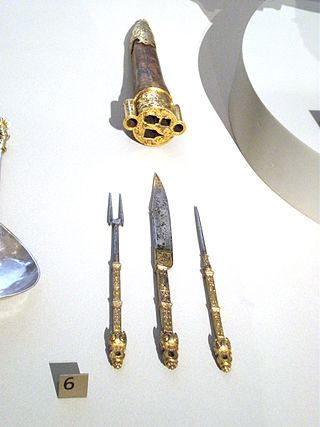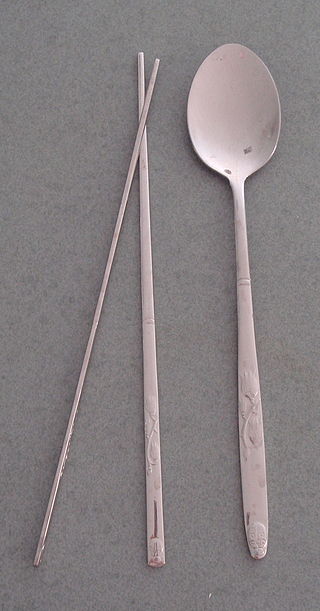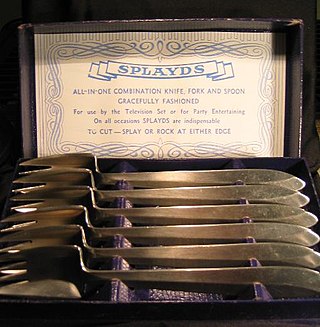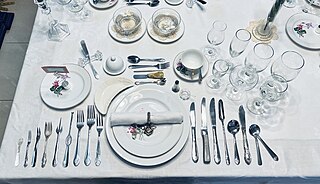
A spoon is a utensil consisting of a shallow bowl, oval or round, at the end of a handle. A type of cutlery, especially as part of a place setting, it is used primarily for transferring food to the mouth. Spoons are also used in food preparation to measure, mix, stir and toss ingredients and for serving food. Present day spoons are made from metal, wood, porcelain or plastic. There are a wide variety of spoons that are made of a variety of materials and by different cultures for many different uses and foods.

In cutlery or kitchenware, a fork is a utensil, now usually made of metal, whose long handle terminates in a head that branches into several narrow and often slightly curved tines with which one can spear foods either to hold them to cut with a knife or to lift them to the mouth.

Cutlery, includes any hand implement used in preparing, serving, and especially eating food in Western culture. A person who makes or sells cutlery is called a cutler. The city of Sheffield in England has been famous for the production of cutlery since the 17th century and a train – the Master Cutler – running from Sheffield to London was named after the industry. Bringing affordable cutlery to the masses, stainless steel was developed in Sheffield in the early 20th century.

Table setting or place setting refers to the way to set a table with tableware—such as eating utensils and for serving and eating. The arrangement for a single diner is called a place setting. It is also the layout in which the utensils and ornaments are positioned. The practice of dictating the precise arrangement of tableware has varied across cultures and historical periods.

Tableware items are the dishware and utensils used for setting a table, serving food, and dining. The term includes cutlery, glassware, serving dishes, serving utensils, and other items used for practical as well as decorative purposes. The quality, nature, variety and number of objects varies according to culture, religion, number of diners, cuisine and occasion. For example, Middle Eastern, Indian or Polynesian food culture and cuisine sometimes limits tableware to serving dishes, using bread or leaves as individual plates, and not infrequently without use of cutlery. Special occasions are usually reflected in higher quality tableware.

Sujeo (Korean: 수저) is the Korean term for the set of eating utensils commonly used to eat Korean cuisine. The word is a portmanteau of the words sutgarak and jeotgarak. The sujeo set includes a pair of oval-shaped or rounded-rectangular metal chopsticks, and a long handled shallow spoon of the same material. One may use both at the same time, but this is a recent way to eat quicker. It is not considered good etiquette to hold the spoon and the chopstick together in one hand especially while eating with elders. More often food is eaten with chopsticks alone. Sometimes the spoon apart from chopsticks is referred to as sujeo.

A splayd is an eating utensil combining the functions of spoon, knife and fork. It was invented by William McArthur in the 1940s in Sydney, New South Wales, Australia. There are several manufacturers.

A full-course dinner is a meal with multiple courses, almost invariably eaten in the evening or afternoon. Most Western-world multicourse meals follow a standard sequence, influenced by traditional French haute cuisine. It commonly begins with an appetizer, followed by the main course, the salad course, and eventually the dessert, but the exact sequence varies widely. Full-course dinners are generally very formal as well as very expensive, and can have as little as 3 or as many as 21 courses. Some major styles include service à la russe and service à la française.

Table manners are the rules of etiquette used while eating, which may also include the use of utensils. Different cultures observe different rules for table manners. Each family or group sets its own standards for how strictly these rules are to be followed.

Etiquette in Asia varies from country to country even though certain actions may seem to be common. No article on the rules of etiquette, nor any list of faux pas, can ever be complete. As the perception of behaviors and actions vary, intercultural competence is essential. A lack of knowledge about the customs and expectations of Asian people can make even those with good intentions seem rude, foolish, and disrespectful.
The Montreal–Philippines cutlery controversy was an incident in 2006 in which a Filipino-born Canadian boy was punished by his school in Roxboro, Montreal, for following traditional Filipino etiquette and eating his lunch with a fork and a spoon, rather than the Canadian tradition of a knife and fork.

A finger bowl is a bowl of water that dinner guests use for rinsing their fingers. In a formal meal, the finger bowl is brought to the table at the time of the dessert course of the meal, and guests set it aside for use after the last course, just before leaving the table. In less formal service, the finger bowl may be presented after any course that involves finger food and may even be presented after more than one such course in a single meal.

Chopsticks are shaped pairs of equal-length sticks that have been used as kitchen and eating utensils in most of East Asia for over three millennia. They are held in the dominant hand, secured by fingers, and wielded as extensions of the hand, to pick up food.

Customs and etiquette in Chinese dining are the traditional behaviors observed while eating in Greater China. Traditional Han customs have spread throughout East Asia to varying degrees, with some regions sharing a few aspects of formal dining, which has ranged from guest seating to paying the bill.

A steak knife is a sharp table knife designed to efficiently and effectively cut steak. This type of knife comes in a variety of styles and sizes; however, the design often used in a steakhouse typically features a partially serrated blade and wood handle.

Kamayan, also known as kinamot or kinamut in Visayan languages, is the traditional Filipino method of eating with the bare hands. It is also used to describe the Filipino communal feast where food is served on banana leaves and eaten without utensils.

Table manners are the cultural customs and rules of etiquette used while dining. As in other areas of North American etiquette, the rules governing appropriate table manners have changed over time and may differ depending on the setting.

Japanese dining etiquette is a set of traditional perceptions governing specific expectations which outlines general standards of how one should behave and respond in various dining situations.

Combination eating utensils, also known as hybrid utensils, are utensils that have the qualities of other utensils combined into one. This can be done to make a more convenient, less wasteful, or more cost-efficient product. Many different types of combination utensils have been created, each designed to serve a different purpose.



















